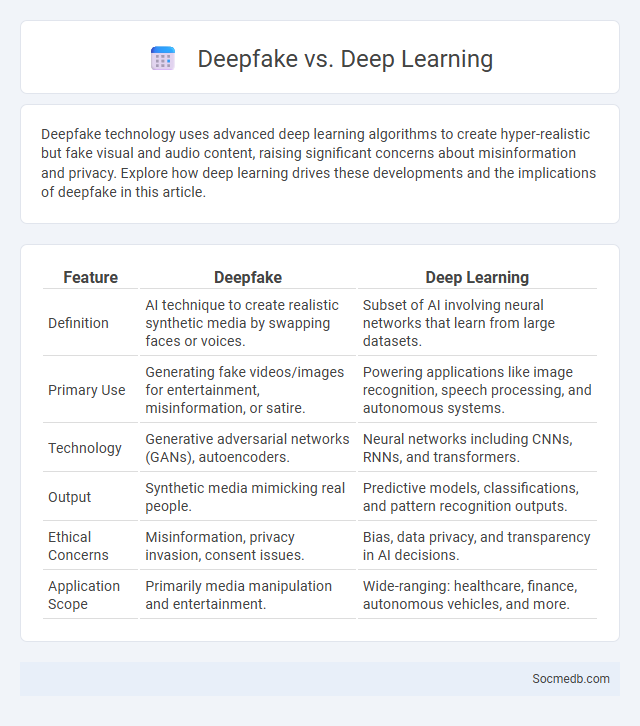
Photo illustration: Deepfake vs Deep Learning
Deepfake technology uses advanced deep learning algorithms to create hyper-realistic but fake visual and audio content, raising significant concerns about misinformation and privacy. Explore how deep learning drives these developments and the implications of deepfake in this article.
Table of Comparison
| Feature | Deepfake | Deep Learning |
|---|---|---|
| Definition | AI technique to create realistic synthetic media by swapping faces or voices. | Subset of AI involving neural networks that learn from large datasets. |
| Primary Use | Generating fake videos/images for entertainment, misinformation, or satire. | Powering applications like image recognition, speech processing, and autonomous systems. |
| Technology | Generative adversarial networks (GANs), autoencoders. | Neural networks including CNNs, RNNs, and transformers. |
| Output | Synthetic media mimicking real people. | Predictive models, classifications, and pattern recognition outputs. |
| Ethical Concerns | Misinformation, privacy invasion, consent issues. | Bias, data privacy, and transparency in AI decisions. |
| Application Scope | Primarily media manipulation and entertainment. | Wide-ranging: healthcare, finance, autonomous vehicles, and more. |
Introduction to Deepfake and Deep Learning
Deep learning techniques power the creation of deepfake content, utilizing neural networks to generate highly realistic yet fabricated images, videos, or audio. Social media platforms have seen a surge in deepfake usage, posing challenges for content authenticity and user trust. Understanding deep learning's role helps You critically evaluate the information encountered online and recognize manipulated media.
What is Deepfake Technology?
Deepfake technology uses artificial intelligence and deep learning algorithms to create hyper-realistic but fake images, videos, or audio recordings that appear genuine. This technology manipulates existing content by swapping faces or altering speech, often leading to misinformation and challenges in verifying authenticity on social media platforms. Protecting your online presence requires awareness of deepfakes and using tools that detect manipulated media to maintain trust and security.
Understanding Deep Learning Fundamentals
Deep learning fundamentals are essential for mastering social media analytics and content optimization, as neural networks process vast amounts of user data to identify patterns and trends. Understanding these concepts can enhance your ability to leverage algorithms that power personalized recommendations and targeted advertising. Your grasp of deep learning enables the creation of more engaging, data-driven social media strategies that improve user interaction and brand visibility.
Deepfake vs Deep Learning: Key Differences
Deepfake technology leverages advanced deep learning algorithms to create hyper-realistic but fake videos or images by manipulating existing media content. Deep learning, a subset of artificial intelligence, involves neural networks that learn from vast amounts of data to perform tasks like image recognition, natural language processing, and autonomous driving. The key difference lies in purpose: deep learning serves broad applications across industries, while deepfake specifically exploits deep learning techniques to fabricate deceptive visual media.
How Deepfake Uses Deep Learning
Deepfake technology leverages deep learning algorithms, specifically generative adversarial networks (GANs), to create highly realistic but fabricated images and videos. These neural networks analyze vast datasets of facial features and expressions to generate synthetic media that can convincingly mimic real individuals. The rapid advancement of deep learning models has significantly enhanced the quality and accessibility of deepfakes, raising ethical concerns in social media about misinformation and privacy.
Applications of Deepfake in Media
Deepfake technology revolutionizes social media by enabling hyper-realistic video and audio content for entertainment, marketing, and personalized storytelling. Media platforms leverage deepfake applications to create immersive virtual influencers, enhance visual effects, and automate content generation with high authenticity. Ethical challenges and misinformation risks prompt the development of advanced detection algorithms and regulatory frameworks to ensure responsible deepfake use.
Ethical Concerns with Deepfake Technology
Deepfake technology raises significant ethical concerns in social media, including the potential for misinformation, identity theft, and manipulation of public opinion. The ease of creating highly realistic fake videos challenges content authenticity and undermines trust in digital communication platforms. Implementing robust detection algorithms and promoting digital literacy are critical to mitigating the harmful impacts of deepfakes on social media ecosystems.
Benefits and Risks of Deep Learning
Deep learning enhances social media platforms by enabling personalized content recommendations, improving facial recognition, and detecting harmful behavior such as hate speech or fake accounts, thereby boosting user engagement and platform safety. Your data privacy faces risks due to potential misuse of deep learning algorithms that can infer sensitive information or perpetuate biases in content moderation. Balancing these benefits and risks is crucial to optimize user experience while protecting personal information and ensuring ethical algorithmic practices.
Detecting and Preventing Deepfakes
Advanced algorithms and machine learning models play a crucial role in detecting deepfakes on social media platforms by analyzing inconsistencies in facial movements, audio-visual synchronization, and metadata anomalies. Social media companies implement real-time monitoring systems combined with user reporting mechanisms to flag and remove manipulated content promptly. Collaboration with cybersecurity experts and continuous updates to detection tools enhance the prevention of deepfakes, safeguarding user trust and platform integrity.
Future Trends: Deepfake and Deep Learning
Deepfake technology, powered by advanced deep learning algorithms, is transforming social media by creating hyper-realistic synthetic media that can both engage and deceive users. Your experience on social platforms will increasingly involve AI-generated content, raising important concerns about authenticity, trust, and the need for robust detection tools. Embracing these future trends requires awareness of how deep learning enhances content creation while addressing ethical and security challenges in digital communication.
 socmedb.com
socmedb.com